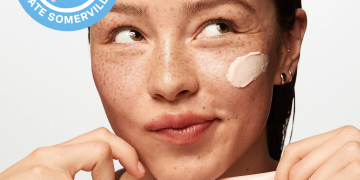Your skin barrier, also known as the stratum corneum, plays a critical role in maintaining skin health. It serves as a protective shield, locking in moisture and shielding your skin from environmental aggressors like pollutants, bacteria, and UV rays. However, an improperly managed skincare routine can unintentionally harm this vital layer, leading to dryness, irritation, and sensitivity. Understanding the importance of your skin barrier and how to care for it can help you maintain resilient, glowing skin.
What is the Skin Barrier and Why Is It Important?
The skin barrier is the outermost layer of the epidermis, composed of corneocytes (dead skin cells) held together by lipids (natural fats). This structure is often likened to a brick-and-mortar wall:
- Bricks: The corneocytes, which form the wall’s structure.
- Mortar: Lipids, including ceramides, cholesterol, and fatty acids, which fill the gaps and keep the structure intact.
A healthy skin barrier prevents trans-epidermal water loss (TEWL) and keeps harmful elements from penetrating the skin. When this barrier is compromised, skin becomes vulnerable to dehydration, irritation, and infections.
Signs of a Damaged Skin Barrier
Identifying a compromised skin barrier early can help prevent further damage. Common signs include:
- Dryness and Flakiness: Skin may feel tight, rough, and appear visibly dehydrated.
- Increased Sensitivity: You may experience stinging, burning, or redness after applying products.
- Redness and Irritation: Persistent inflammation or blotchy skin often indicates damage.
- Breakouts: A weakened barrier allows bacteria to penetrate more easily, leading to acne.
- Itchiness or Rough Texture: A damaged barrier often manifests as discomfort and uneven texture.
Common Causes of Skin Barrier Damage
Many everyday habits and products can weaken the skin barrier, often without you realizing it:
1. Over-Cleansing
Using harsh or overly alkaline cleansers strips the skin of its natural oils, disrupting its lipid layer.
2. Excessive Exfoliation
While exfoliation can brighten and smooth skin, overdoing it—especially with abrasive scrubs or high-concentration acids—can thin the barrier and cause irritation.
3. Skipping Moisturizer
Failing to moisturize deprives the skin of essential hydration, making it more susceptible to damage.
4. Environmental Stressors
Exposure to UV rays, pollution, and extreme weather conditions can deplete the skin’s lipid reserves, weakening its defenses.
5. Incorrect Use of Active Ingredients
Ingredients like retinoids, AHAs, and BHAs, when overused or improperly layered, can lead to barrier disruption.
Steps to Repair and Strengthen Your Skin Barrier
If your skin barrier is compromised, adopting a barrier-friendly routine is crucial for recovery and maintenance. Here’s how to do it:
1. Simplify Your Routine
Eliminate harsh or unnecessary products and focus on gentle, hydrating basics:
- A mild cleanser
- A nourishing moisturizer
- Sunscreen
2. Choose Barrier-Repairing Ingredients
Look for products formulated with:
- Ceramides: Essential for replenishing the skin’s lipid layer.
- Hyaluronic Acid: Provides hydration and attracts moisture to the skin.
- Squalane: Mimics natural skin oils to boost hydration.
- Niacinamide: Reduces redness, strengthens the barrier, and improves moisture retention.
- Panthenol (Vitamin B5): Soothes irritation and supports barrier repair.
3. Avoid Over-Exfoliation
Limit exfoliation to 1-2 times per week, and choose gentler options like lactic acid or enzymatic exfoliants.
4. Protect Against Environmental Stressors
- Sunscreen: Use a broad-spectrum sunscreen with SPF 30 or higher daily.
- Antioxidants: Incorporate products with vitamin C or green tea extract to combat free radicals.
- Humidifiers: Use a humidifier to maintain indoor moisture levels, especially in dry climates.
5. Moisturize Effectively
Apply moisturizer while your skin is still damp after cleansing to lock in hydration. Opt for rich creams if your skin feels particularly dry or compromised.
Preventing Future Skin Barrier Damage
Adopting protective habits ensures your skin barrier remains healthy and resilient over time:
1. Be Gentle with Cleansing
- Use lukewarm water instead of hot water to prevent dehydration.
- Opt for sulfate-free, pH-balanced cleansers to avoid stripping natural oils.
2. Use Products Mindfully
- Introduce active ingredients gradually to allow your skin to adapt.
- Avoid layering too many actives in one routine.
3. Prioritize Hydration
Stay hydrated by drinking water and incorporating water-rich foods like cucumbers and watermelon into your diet.
4. Manage Stress
Chronic stress disrupts the skin’s natural repair processes. Engage in stress-reducing activities like yoga, meditation, or exercise.
Myths About the Skin Barrier
Understanding what doesn’t harm the skin barrier can help you focus on effective practices:
1. “Oily Skin Doesn’t Need Moisturizer.”
All skin types benefit from moisturizers. Even oily skin requires hydration to maintain a healthy barrier.
2. “Tingling Means a Product is Working.”
Tingling often signals irritation rather than efficacy. Opt for gentler formulations if you experience this sensation.
3. “More Exfoliation Equals Better Results.”
Excessive exfoliation damages the skin rather than improving it. Stick to a moderate schedule for optimal results.
Signs Your Barrier is Healing
A restored skin barrier will exhibit:
- Increased hydration and less tightness
- Reduced redness and sensitivity
- Smoother, more even texture
- Improved resilience to products and environmental factors
By nurturing your skin barrier with gentle care and protective practices, you can enjoy healthier, glowing skin that stands up to daily challenges.










